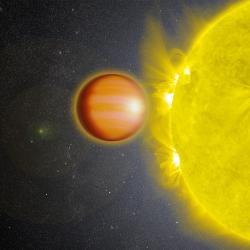NASA’s Parker Solar Probe Reveals a Key Particle Accelerator Near the Sun
University of Maryland researchers helped to interpret the sun-bound spacecraft’s explosive observations.

Flying closer to the sun than any spacecraft before it, NASA’s Parker Solar Probe uncovered a new source of energetic particles near Earth’s star, according to a new study co-authored by University of Maryland researchers.
Published in The Astrophysical Journal Letters on May 29, 2025, the paper suggests that a process linked to magnetic reconnection—the explosive merging and realigning of magnetic field lines—could propel particles near the sun to extremely high energy. The data sheds light on processes that were impossible to observe in such a harsh environment before Parker launched in 2018, according to study co-author and University of Maryland researcher James Drake.
“We now, for the first time, have a spacecraft that is going through an enormous magnetic reconnection event and can directly measure everything, and that's simply never happened before,” said Drake, a Distinguished University Professor in UMD’s Department of Physics and Institute for Physical Science and Technology (IPST).
Study co-author and Parker Solar Probe project scientist Nour Rawafi, who is also a heliophysicist at the Johns Hopkins Applied Physics Laboratory, added that Parker is enabling researchers to see unexplored regions of the sun.
“Parker Solar Probe was designed to solve some of the sun’s biggest mysteries and uncover hidden processes we couldn’t detect from afar,” Rawafi said, “and this discovery hits right at the heart of that mission.”
Drake and Marc Swisdak, a research scientist in UMD’s Institute for Research in Electronics & Applied Physics (IREAP), were tapped to help analyze Parker Solar Probe data because of their expertise in magnetic reconnection. The two UMD researchers previously identified the mechanism driving the sun’s fast wind and have now interpreted data from a massive magnetic reconnection event measuring four times the size of the sun, according to Drake.
This data was collected during Parker’s fourteenth swing by the sun in December 2022, when the probe crossed the heliospheric current sheet (HCS), an undulating structure invisible to human eyes. Like a twirling flamenco skirt, the sheet separates regions where the sun’s magnetic field points in opposite directions.
Ripples in the current sheet cause the magnetic fields to merge and rearrange through magnetic reconnection. This releases energy explosively, catapulting a jet of charged particles away as an “exhaust” of energized particles. That same phenomenon affects the Earth-space environment, creating auroral shows at Earth’s poles and geomagnetic storms capable of disrupting satellite communications and causing blackouts.
For nearly four hours in late 2022, Parker passed through the exhaust generated by these reconnection events in the HCS. There, it encountered protons being accelerated, unexpectedly, toward the sun—quashing any doubt over where this energy came from.
“These findings indicate that magnetic reconnection in the HCS is an important source of energetic particles in the near-sun solar wind,” said the study’s lead author Mihir Desai, a solar physicist at the Southwest Research Institute.
Some of the protons that Parker measured had nearly 1,000 times more energy than what could have been transferred by the available magnetic energy. To help pinpoint the mechanism for this surprising energy gain, Drake, Swisdak and IREAP Faculty Assistant Zhiyu Yin (Ph.D. ’24, physics) ran a simulation using a computational model that had been in development for several years at UMD. This study marks the first time their model has been used to directly simulate an observable event.
“From that simulation, we calculated the spectrum of energetic particles and then compared that with what was seen in the Parker data, and we were able to get a pretty good match,” Drake explained.
Their simulations also confirmed earlier studies, including a 2006 paper co-authored by Drake and Swisdak, which identified “magnetic islands”—loops of the magnetic field that pinch off like water droplets when field lines merge—as the source of this extra energy boost. Particles trapped within the loops get an additional kick as the islands merge and shed their own energy, accelerating some particles nearly to the speed of light.
“The mechanisms we saw in this study seem consistent with what we have been working on for nearly 20 years, but what surprised me is that these particles gain so much energy,” Drake said. “One important thing about this set of observations is that it demonstrates that magnetic energy can get focused into a small number of extremely energetic particles.”
In addition to demystifying energy exchanges near the sun, learning more about magnetic reconnection—and any resulting solar flares—can help astronauts stay safe.
“These energetic particles are a threat to astronauts if they're out in space,” Drake said. “In a solar flare, you can get some dangerous particles that reach extremely high energies.”
As researchers continue to explore these problems through Parker Solar Probe data, Drake hopes that future observations will chart the spectra of electrons in magnetic reconnection events—a missing piece of the puzzle.
“Our simulations show that the electrons have a lot of energy, but the data we published in this paper don't show the electron spectrum at all,” Drake explained. “One of the important questions is, ‘What carries more energy: the protons or the electrons undergoing acceleration?’ That's one important aspect that we would really like to follow up on.”
###
This article was adapted from text provided by the Johns Hopkins Applied Physics Lab and the Southwest Research Institute.
Their paper, “Magnetic Reconnection–driven Energization of Protons up to ∼400 keV at the Near-Sun Heliospheric Current Sheet,” was published May 29, 2025, in The Astrophysical Journal Letters.
This research was supported by NASA's Parker Solar Probe Mission (Contract No. NNN06AA01C), NASA grants (Nos. 80NSSC20K1815, 80NSSC18K1446, 80NSSC21K0112, 80NSSC20K1255, 80NSSC21K0971 and 80NSSC21K1765), the U.S. National Science Foundation (Grant No. PHY2109083) and Princeton University. This article does not necessarily reflect the views of these organizations.







